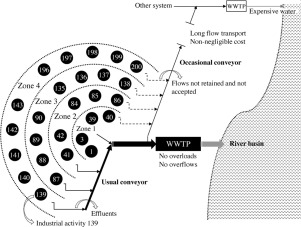当前位置:
X-MOL 学术
›
Process Saf. Environ. Prot.
›
论文详情
Our official English website, www.x-mol.net, welcomes your
feedback! (Note: you will need to create a separate account there.)
A new optimization model for wastewater treatment planning with a temporal component
Process Safety and Environmental Protection ( IF 6.9 ) Pub Date : 2020-04-01 , DOI: 10.1016/j.psep.2019.12.034 Christian Blum , Marta Verdaguer , Hèctor Monclús , Manel Poch
Process Safety and Environmental Protection ( IF 6.9 ) Pub Date : 2020-04-01 , DOI: 10.1016/j.psep.2019.12.034 Christian Blum , Marta Verdaguer , Hèctor Monclús , Manel Poch

|
Abstract The management of wastewater systems constitutes a complex problem in the environmental engineering field. The variability and uncertainty of the inflows of wastewater treatment plants involve a real risk of reducing the effectiveness of the treatments and worsen the ecological state of river basins. An adequate reduction of contaminants requires an optimal combination of wastewater contributions that must constitute the treatment inflow. The problem is complex because of different dynamics and casuistics of wastewater generation, especially when the waste is from industrial activities. In addition, a realistic focus requires consideration of the temporal component due to the distances from the treatment. This paper presents a new optimization model for planning the wastewater inflow in a consistent way, with the novelty from the inclusion of this temporal component. Under the assumption of a complete knowledge of the future, the problem can be expressed as a quadratically constrained program (QCP). With growing problem size, solvers such as CONOPT have increasing difficulties to find good solutions to such problems. Therefore, we propose solving this problem as an online optimization problem in which the quadratic terms are eliminated. Our approach was applied to a virtual case study based on a high number (200) of industrial wastewater generators (located in 4 different zones) and a single wastewater treatment plant. The results obtained evidence the applicability of the model to plan favourably the operation of treatments and contribute to sustainability in the context of the internet of things.
中文翻译:

一种新的具有时间分量的污水处理规划优化模型
摘要 废水系统的管理是环境工程领域的一个复杂问题。污水处理厂流入量的可变性和不确定性涉及降低处理效果和恶化流域生态状况的真实风险。污染物的充分减少需要必须构成处理流入的废水贡献的最佳组合。由于废水产生的不同动态和因果关系,这个问题很复杂,特别是当废物来自工业活动时。此外,由于与治疗的距离,现实的焦点需要考虑时间分量。本文提出了一种新的优化模型,用于以一致的方式规划废水流入量,包含这个时间组件的新颖性。在完全了解未来的假设下,问题可以表示为二次约束程序(QCP)。随着问题规模不断扩大,CONOPT 等求解器越来越难以找到此类问题的良好解决方案。因此,我们建议将此问题作为消除二次项的在线优化问题来解决。我们的方法应用于基于大量 (200) 工业废水发生器(位于 4 个不同区域)和单个废水处理厂的虚拟案例研究。获得的结果证明该模型适用于有利地规划治疗操作并有助于物联网背景下的可持续性。在完全了解未来的假设下,问题可以表示为二次约束程序(QCP)。随着问题规模不断扩大,CONOPT 等求解器越来越难以找到此类问题的良好解决方案。因此,我们建议将此问题作为消除二次项的在线优化问题来解决。我们的方法应用于基于大量 (200) 工业废水发生器(位于 4 个不同区域)和单个废水处理厂的虚拟案例研究。获得的结果证明该模型适用于有利地规划治疗操作并有助于物联网背景下的可持续性。在完全了解未来的假设下,问题可以表示为二次约束程序(QCP)。随着问题规模不断扩大,CONOPT 等求解器越来越难以找到此类问题的良好解决方案。因此,我们建议将此问题作为消除二次项的在线优化问题来解决。我们的方法应用于基于大量 (200) 工业废水发生器(位于 4 个不同区域)和单个废水处理厂的虚拟案例研究。获得的结果证明该模型适用于有利地规划治疗操作并有助于物联网背景下的可持续性。随着问题规模不断扩大,CONOPT 等求解器越来越难以找到此类问题的良好解决方案。因此,我们建议将此问题作为消除二次项的在线优化问题来解决。我们的方法应用于基于大量 (200) 工业废水发生器(位于 4 个不同区域)和单个废水处理厂的虚拟案例研究。获得的结果证明该模型适用于有利地规划治疗操作并有助于物联网背景下的可持续性。随着问题规模不断扩大,CONOPT 等求解器越来越难以找到此类问题的良好解决方案。因此,我们建议将此问题作为消除二次项的在线优化问题来解决。我们的方法应用于基于大量 (200) 工业废水发生器(位于 4 个不同区域)和单个废水处理厂的虚拟案例研究。获得的结果证明该模型适用于有利地规划治疗操作并有助于物联网背景下的可持续性。我们的方法应用于基于大量 (200) 工业废水发生器(位于 4 个不同区域)和单个废水处理厂的虚拟案例研究。获得的结果证明该模型适用于有利地规划治疗操作并有助于物联网背景下的可持续性。我们的方法应用于基于大量 (200) 工业废水发生器(位于 4 个不同区域)和单个废水处理厂的虚拟案例研究。获得的结果证明该模型适用于有利地规划治疗操作并有助于物联网背景下的可持续性。
更新日期:2020-04-01
中文翻译:

一种新的具有时间分量的污水处理规划优化模型
摘要 废水系统的管理是环境工程领域的一个复杂问题。污水处理厂流入量的可变性和不确定性涉及降低处理效果和恶化流域生态状况的真实风险。污染物的充分减少需要必须构成处理流入的废水贡献的最佳组合。由于废水产生的不同动态和因果关系,这个问题很复杂,特别是当废物来自工业活动时。此外,由于与治疗的距离,现实的焦点需要考虑时间分量。本文提出了一种新的优化模型,用于以一致的方式规划废水流入量,包含这个时间组件的新颖性。在完全了解未来的假设下,问题可以表示为二次约束程序(QCP)。随着问题规模不断扩大,CONOPT 等求解器越来越难以找到此类问题的良好解决方案。因此,我们建议将此问题作为消除二次项的在线优化问题来解决。我们的方法应用于基于大量 (200) 工业废水发生器(位于 4 个不同区域)和单个废水处理厂的虚拟案例研究。获得的结果证明该模型适用于有利地规划治疗操作并有助于物联网背景下的可持续性。在完全了解未来的假设下,问题可以表示为二次约束程序(QCP)。随着问题规模不断扩大,CONOPT 等求解器越来越难以找到此类问题的良好解决方案。因此,我们建议将此问题作为消除二次项的在线优化问题来解决。我们的方法应用于基于大量 (200) 工业废水发生器(位于 4 个不同区域)和单个废水处理厂的虚拟案例研究。获得的结果证明该模型适用于有利地规划治疗操作并有助于物联网背景下的可持续性。在完全了解未来的假设下,问题可以表示为二次约束程序(QCP)。随着问题规模不断扩大,CONOPT 等求解器越来越难以找到此类问题的良好解决方案。因此,我们建议将此问题作为消除二次项的在线优化问题来解决。我们的方法应用于基于大量 (200) 工业废水发生器(位于 4 个不同区域)和单个废水处理厂的虚拟案例研究。获得的结果证明该模型适用于有利地规划治疗操作并有助于物联网背景下的可持续性。随着问题规模不断扩大,CONOPT 等求解器越来越难以找到此类问题的良好解决方案。因此,我们建议将此问题作为消除二次项的在线优化问题来解决。我们的方法应用于基于大量 (200) 工业废水发生器(位于 4 个不同区域)和单个废水处理厂的虚拟案例研究。获得的结果证明该模型适用于有利地规划治疗操作并有助于物联网背景下的可持续性。随着问题规模不断扩大,CONOPT 等求解器越来越难以找到此类问题的良好解决方案。因此,我们建议将此问题作为消除二次项的在线优化问题来解决。我们的方法应用于基于大量 (200) 工业废水发生器(位于 4 个不同区域)和单个废水处理厂的虚拟案例研究。获得的结果证明该模型适用于有利地规划治疗操作并有助于物联网背景下的可持续性。我们的方法应用于基于大量 (200) 工业废水发生器(位于 4 个不同区域)和单个废水处理厂的虚拟案例研究。获得的结果证明该模型适用于有利地规划治疗操作并有助于物联网背景下的可持续性。我们的方法应用于基于大量 (200) 工业废水发生器(位于 4 个不同区域)和单个废水处理厂的虚拟案例研究。获得的结果证明该模型适用于有利地规划治疗操作并有助于物联网背景下的可持续性。










































 京公网安备 11010802027423号
京公网安备 11010802027423号